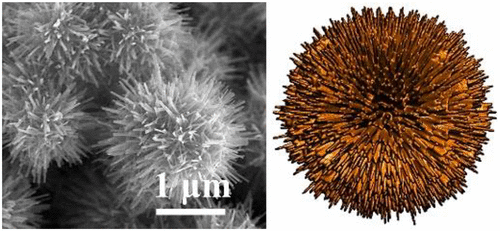当前位置:
X-MOL 学术
›
J. Am. Chem. Soc.
›
论文详情
Our official English website, www.x-mol.net, welcomes your
feedback! (Note: you will need to create a separate account there.)
Self-Assembly Mechanism of Complex Corrugated Particles
Journal of the American Chemical Society ( IF 14.4 ) Pub Date : 2021-11-16 , DOI: 10.1021/jacs.1c05488 Lanqin Tang 1, 2, 3 , Thi Vo 2, 3 , Xiaoxing Fan 2, 4 , Drew Vecchio 2 , Tao Ma 5, 6 , Jun Lu 2, 3 , Harrison Hou 2, 3 , Sharon C Glotzer 2, 3 , Nicholas A Kotov 2, 3
Journal of the American Chemical Society ( IF 14.4 ) Pub Date : 2021-11-16 , DOI: 10.1021/jacs.1c05488 Lanqin Tang 1, 2, 3 , Thi Vo 2, 3 , Xiaoxing Fan 2, 4 , Drew Vecchio 2 , Tao Ma 5, 6 , Jun Lu 2, 3 , Harrison Hou 2, 3 , Sharon C Glotzer 2, 3 , Nicholas A Kotov 2, 3
Affiliation

|
A variety of inorganic nanoscale materials produce microscale particles with highly corrugated geometries, but the mechanism of their formation remains unknown. Here we found that uniformly sized CdS-based hedgehog particles (HPs) self-assemble from polydisperse nanoparticles (NPs) with diameters of 1.0–4.0 nm. The typical diameters of HPs and spikes are 1770 ± 180 and 28 ± 3 nm, respectively. Depending on the temperature, solvent, and reaction times, the NPs self-assemble into nanorods, nanorod aggregates, low-corrugation particles, and other HP-related particles with complexity indexes ranging from 0 to 23.7. We show that “hedgehog”, other geometries, and topologies of highly corrugated particles originate from the thermodynamic preference of polydisperse NPs to attach to the growing nanoscale cluster when electrostatic repulsion competes with van der Waals attraction. Theoretical models and simulations of the self-assembly accounting for the competition of attractive and repulsive interactions in electrolytes accurately describe particle morphology, growth stages, and the spectrum of observed products. When kinetic parameters are included in the models, the formation of corrugated particles with surfaces decorated by nanosheets, known as flower-like particles, were theoretically predicted and experimentally observed. The generality of the proposed mechanism was demonstrated for the formation of mixed HPs via a combination of CdS and Co3O4 NPs. With unusually high dispersion stability of HPs in unfavorable solvents including liquid CO2, mechanistic insights into HP formation are essential for their structural adaptation for applications from energy storage, catalysis, water treatment, and others.
中文翻译:

复杂波纹粒子的自组装机制
多种无机纳米级材料产生具有高度波纹几何形状的微米级颗粒,但它们的形成机制仍然未知。在这里,我们发现均匀尺寸的基于 CdS 的刺猬粒子 (HPs) 从直径为 1.0-4.0 nm 的多分散纳米粒子 (NPs) 自组装。HP 和尖峰的典型直径分别为 1770 ± 180 和 28 ± 3 nm。根据温度、溶剂和反应时间,NPs 自组装成纳米棒、纳米棒聚集体、低波纹颗粒和其他复杂指数范围为 0 至 23.7 的 HP 相关颗粒。我们展示了“刺猬”,其他几何形状,当静电排斥与范德华引力竞争时,高度波纹粒子的拓扑结构源于多分散纳米粒子的热力学偏好,以附着在不断增长的纳米级簇上。自组装的理论模型和模拟解释了电解质中吸引和排斥相互作用的竞争,准确地描述了粒子形态、生长阶段和观察到的产物的光谱。当模型中包含动力学参数时,理论上预测和实验观察到表面由纳米片装饰的波纹颗粒(称为花状颗粒)的形成。通过 CdS 和 Co 的组合,证明了所提出机制的普遍性,用于形成混合 HP 自组装的理论模型和模拟解释了电解质中吸引和排斥相互作用的竞争,准确地描述了粒子形态、生长阶段和观察到的产物的光谱。当模型中包含动力学参数时,理论上预测和实验观察到表面由纳米片装饰的波纹颗粒(称为花状颗粒)的形成。通过 CdS 和 Co 的组合,证明了所提出机制的普遍性,用于形成混合 HP 自组装的理论模型和模拟解释了电解质中吸引和排斥相互作用的竞争,准确地描述了粒子形态、生长阶段和观察到的产物的光谱。当模型中包含动力学参数时,理论上预测和实验观察到表面由纳米片装饰的波纹颗粒(称为花状颗粒)的形成。通过 CdS 和 Co 的组合,证明了所提出机制的普遍性,用于形成混合 HP 理论上预测和实验观察到表面被纳米片装饰的波纹状颗粒(称为花状颗粒)的形成。通过 CdS 和 Co 的组合,证明了所提出机制的普遍性,用于形成混合 HP 理论上预测和实验观察到表面被纳米片装饰的波纹状颗粒(称为花状颗粒)的形成。通过 CdS 和 Co 的组合,证明了所提出机制的普遍性,用于形成混合 HP3 O 4 NP。由于 HP 在包括液态 CO 2在内的不利溶剂中具有异常高的分散稳定性,因此深入了解 HP 形成的机理对于它们在储能、催化、水处理等应用中的结构适应至关重要。
更新日期:2021-12-01
中文翻译:

复杂波纹粒子的自组装机制
多种无机纳米级材料产生具有高度波纹几何形状的微米级颗粒,但它们的形成机制仍然未知。在这里,我们发现均匀尺寸的基于 CdS 的刺猬粒子 (HPs) 从直径为 1.0-4.0 nm 的多分散纳米粒子 (NPs) 自组装。HP 和尖峰的典型直径分别为 1770 ± 180 和 28 ± 3 nm。根据温度、溶剂和反应时间,NPs 自组装成纳米棒、纳米棒聚集体、低波纹颗粒和其他复杂指数范围为 0 至 23.7 的 HP 相关颗粒。我们展示了“刺猬”,其他几何形状,当静电排斥与范德华引力竞争时,高度波纹粒子的拓扑结构源于多分散纳米粒子的热力学偏好,以附着在不断增长的纳米级簇上。自组装的理论模型和模拟解释了电解质中吸引和排斥相互作用的竞争,准确地描述了粒子形态、生长阶段和观察到的产物的光谱。当模型中包含动力学参数时,理论上预测和实验观察到表面由纳米片装饰的波纹颗粒(称为花状颗粒)的形成。通过 CdS 和 Co 的组合,证明了所提出机制的普遍性,用于形成混合 HP 自组装的理论模型和模拟解释了电解质中吸引和排斥相互作用的竞争,准确地描述了粒子形态、生长阶段和观察到的产物的光谱。当模型中包含动力学参数时,理论上预测和实验观察到表面由纳米片装饰的波纹颗粒(称为花状颗粒)的形成。通过 CdS 和 Co 的组合,证明了所提出机制的普遍性,用于形成混合 HP 自组装的理论模型和模拟解释了电解质中吸引和排斥相互作用的竞争,准确地描述了粒子形态、生长阶段和观察到的产物的光谱。当模型中包含动力学参数时,理论上预测和实验观察到表面由纳米片装饰的波纹颗粒(称为花状颗粒)的形成。通过 CdS 和 Co 的组合,证明了所提出机制的普遍性,用于形成混合 HP 理论上预测和实验观察到表面被纳米片装饰的波纹状颗粒(称为花状颗粒)的形成。通过 CdS 和 Co 的组合,证明了所提出机制的普遍性,用于形成混合 HP 理论上预测和实验观察到表面被纳米片装饰的波纹状颗粒(称为花状颗粒)的形成。通过 CdS 和 Co 的组合,证明了所提出机制的普遍性,用于形成混合 HP3 O 4 NP。由于 HP 在包括液态 CO 2在内的不利溶剂中具有异常高的分散稳定性,因此深入了解 HP 形成的机理对于它们在储能、催化、水处理等应用中的结构适应至关重要。











































 京公网安备 11010802027423号
京公网安备 11010802027423号